Wayne C. Allen's Blog, page 24
February 12, 2018
Rumi — Mean-spirited Roadhouses

This is post 5 of 5 in the series “Rumi Poems”
Rumi’s Poetry as a Way Inside
Mean-spirited Roadhouses — it’s so very easy to distract ourselves from the truly hard work of self-transformation. It takes great discipline to look deeply at the only thing you can change — your approach to living

Psst! Hey!
** Want more great writing designed to help YOU to shift your behaviour?
** Want to learn how to find, build or deepen your principal relationship?
** Want to know more about Zen living and being?
Many moons ago, I wrote a series of articles featuring some of Rumi’s poems. I think it’s time for a revisit.
Jelaluddin Rumi lived during the 13th century. He was a theologian with his own divinity school. At age 37, through a relationship with a dervish monk, Shams, Rumi began to transform his being, and in the process, to write some of the most beautiful mystical poetry ever written. For the next several weeks, we’ll reflect on some of his poems.
I’m using a translation from the book The Illuminated Rumi.
Mean-spirited Roadhouses
Gamble everything for love,
if you’re a true human being.
If not, leave this gathering.
Half-heartedness doesn’t reach into majesty.
You set out to find God, but then you keep stopping for long periods at mean-spirited roadhouses.
Don’t wait any longer. Dive in the ocean, leave, and let the sea be you.
Silent, absent, walking an empty road, all praise.
Rumi
Or, to quote that famous Jedi master, Yoda,
“Try not. Do. Or do not. There is no try.”
Half-heartedness doesn’t reach into majesty
Now, there’s a line for you … almost as good as the one that follows. Rumi is definitely into total commitment.
One of the real tests for clients and seekers of all stripes is this: how much are you willing to commit, and when, and how? Rumi makes it clear that the kind of life he lives requires the willingness to “gamble everything.”
I like the idea of this being a gamble. A truer thing was never said. No matter how clever we are, no matter what our advantages (or lack thereof)… it’s all still a crap-shoot. Nothing can guarantee results, nothing can assure success… because… it’s a gamble.
Now, that’s not meant to be a discouragement. True human beings, Rumi tells us, gamble it all for love. He sees it in terms of “setting out to find God,” but it’s clear that his mission is nothing less than the transformation of the self.
So, what’s with the mean-spirited roadhouses?
That’s such a good line. Rumi imagines a wanderer — a pilgrim — seeking the silent, empty road that Zen practitioners know so well. It’s the road of silent inward focus.
And then, just like flying into Vegas, there it is! The distraction. The along-the-side-of-the road, road-side attraction that pulls one out of the walk and into the drama.
This was a common theme for clients. Can’t tell you how many walked into the office all set to straighten things out: to change relationships, to be better parents, to find a path worth walking.
And some, maybe 10%, pulled it off. They found the quiet path of self-knowing, dropped dysfunctional game-playing, and in a sense dissolved into the sea of awareness.
Not common, though
 Here I am again…
Here I am again…Most simply found themselves them bellying up to the bar of their favourite mean-spirited roadhouses. And by this I mean they simply did what they always do… and it felt oh so familiar. The comfort of the familiar outweighs the commitment to change.
One person I know is convinced that she is the best parent going: she knows this because she does whatever her teens want her to. She’s highly judgy of her ex’s parenting skills, and as far as I can see, she misses the point of parenting — which is doing herself out of a job. But boy does she think she’s in control.
Others, who have learned another, better lesson, let their teens try and fail, pick themselves up, and walk again. Because that’s how young people learn.
Now, I’m emphatically not making a judgement here. I am suggesting that there are two approaches to life, One is the path of active engagement. The other is “wait and hope” that this time, things will just work out.
The stopping and waiting and hoping, I am convinced, has to do with our fear of pain. Now, if that seems to imply that self-exploration and change is painful, let me state this clearly — self exploration is often painful. Walking a path that is our own is often painful.
But, as Rumi says, this is about finding God, purpose, identity … a life-long walk into the depths of yourself. This, I would suggest, makes the pain worthwhile.
Ruthless self-examination helps us to see how we make our own messes — how we get into trouble, how we let ourselves do things that lead down dark paths.
As we discover these things, we can choose to let them go.
The other folk… the ones who keep praying for magic? They mostly discover mean-spirited roadhouses, and keep stopping in for a beer.
The distractions that cross our path are many, and are all self-created. On the other hand, the solution is found in the willingness to examine our ideas and behaviours, and compassionately make changes.
The point is not to exchange the bludgeon of the world with a ball peen hammer we smack ourselves with. The game is all in the noticing, and then in the choosing to walk on, into a new way of seeing and being.
We can be so self protective of the behaviours and understandings we’ve set up, (despite our self-protective walls getting us nothing that we want) that we forget that we established the walls in the first place.
The final line of the Rumi poem is the ideal. Here, the person has immersed herself in the sea of life and stepped out as a new being. The person’s ego structure is set aside, and the person finds her egoless self.
“Silent, absent, walking an empty road.”
Life, lived to the fullest, is about understanding that you are the source of all that you believe about life, others and yourself. There is nothing else going on.
Stopping by mean-spirited roadhouses for a distraction, to find someone to blame, to simply sit and watch your life pass you by … is precisely the route to nowhere.
Continuing to walk, continuing to see yourself and continuing to make the changes necessary is the ultimate gamble.
And yet, if you wish to be of service, and to truly exhibit love, it’s the only way that leads anywhere.
And where does it lead? To the depths of you. Here and Now. Because Here and Now is all that there ever is.
The post Rumi — Mean-spirited Roadhouses appeared first on The Pathless Path.
February 5, 2018
Rumi — Transformation

This is post 4 of 4 in the series “Rumi Poems”
Rumi’s Poetry as a Way Inside
Ways of Transformation — using yourself up is today’s theme — but in a good way! It’s all about tearing down what isn’t working, and replacing it with what does

Psst! Hey!
** Want more great writing designed to help YOU to shift your behaviour?
** Want to learn how to find, build or deepen your principal relationship?
** Want to know more about Zen living and being?
Back to Ontario for a monta and a bit. Then… Costa Rica!
Many moons ago, I wrote a series of articles featuring some of Rumi’s poems. I think it’s time for a revisit.
Jelaluddin Rumi lived during the 13th century. He was a theologian with his own divinity school. At age 37, through a relationship with a dervish monk, Shams, Rumi began to transform his being, and in the process, to write some of the most beautiful mystical poetry ever written. For the next several weeks, we’ll reflect on some of his poems.
I’m using a translation from the book The Illuminated Rumi.
We Know What to Do
Can you endure silence? Are you a night fighter?
Or more a child bored with outgrown toys
trying to win at tip-the-cat?
If you have any patience left, we know what to do.
If you love sleep, we’ll tear you away.
If you change into a mountain, we’ll melt you.
If you become an ocean, we’ll drain you.
Rumi
Here’s a quote from American writer Jack London:
“I would rather be ashes than dust! I would rather that my spark should burn out in a brilliant blaze than it should be stifled by dry rot. I would rather be a superb meteor, every atom of me a significant glow, than a sleepy and permanent planet. The proper function of man is to live, not to exist. I shall not spend my days trying to prolong them. I shall use my time.”
– Jack London
 Time to wake up…
Time to wake up…I trust you’re noticing that Rumi is an action oriented guy. As, apparently, was Jack London.
In the Rumi quote, there’s a world-view that says, “No matter what you are doing, if you are stuck there, that’s the same as giving up.” The person who is stuck in endless self-exploration is just as stuck as the person who never explores at all.
It’s amazing how many people are deluding themselves. They do workshops, therapy, whatever, read books… and that is it. It’s like being on a treadmill and confusing it with actually going someplace. It’s like studying the package directions until you know them by heart, but then you’re too tired to cook the meal.
We think that we have all the time in the world to become… well… useful. Or, we have a vision, (complete or fragmented) of whom we might be and what contribution we might make, but we creep up on it over years, and somehow our path seems to elude us… to always be “just one more step ahead.”
We create all kinds of reasons and justifications for taking our time.
No money. No time. Too busy working on what we hate, too busy doing what doesn’t work. Too scared. Or the infamous, “What if I don’t like the new version of me?”
All of these things are excuses. And Rumi’s prescription is to destroy the excuse.
If you prefer sleep, we’ll tear you away from your dozing.
If you solidify and lock down and refuse to budge, we’ll melt your resistance.
If you become so insubstantial and fluid that no one can get anywhere near you, we’ll drain you of your pretense, and leave you stripped and bare, seemingly as dry as ashes.
And from there, from the place where resistance is past, we will begin again.
Begin what? To live.
Look at the London quote. Read it a couple of times. He wants us to make something extraordinary happen. Which, to me, begs the question — given the unique nature of each of us, and given the unique skill set of each of us, how is it that we need to be reminded to be unique?
Because for many, that’s what it takes. Re-minding. (Having a new mind in place of the old one. Figuratively, of course… although for a couple of people I know…
January 29, 2018
Rumi — Keep Walking

This is post 3 of 3 in the series “Rumi Poems”
Rumi’s Poetry as a Way Inside
Keep Walking — a reminder that the path through life has no destination (or rather, that destination is death) so the wise person walks with both determination and joy.

Psst! Hey!
** Want more great writing designed to help YOU to shift your behaviour?
** Want to learn how to find, build or deepen your principal relationship?
** Want to know more about Zen living and being?
We’re now in Montreal, or will be today! Soon, back to Ontario.
Many moons ago, I wrote a series of articles featuring some of Rumi’s poems. I think it’s time for a revisit.
Jelaluddin Rumi lived during the 13th century. He was a theologian with his own divinity school. At age 37, through a relationship with a dervish monk, Shams, Rumi began to transform his being, and in the process, to write some of the most beautiful mystical poetry ever written. For the next several weeks, we’ll reflect on some of his poems.
I’m using a translation from the book The Illuminated Rumi.
Keep Walking
Keep walking, though there’s no place to get to.
Don’t try to see through the distances.
That’s not for human beings.
Move within, but don’t move the way fear makes you move.
Today, like every other day, we wake up empty and frightened.
Don’t open the door to the study and begin reading.
Take down a musical instrument.
Let the beauty we love be what we do.
There are hundreds of ways to kneel and kiss the ground.
Rumi
In typical Rumi fashion, we’re jolted by his concept of living “destination-free.”
So, Marrakech is an interesting place. Not much different from what I imagined, but worlds away from my “normal.” Yesterday, we headed out for a light supper, (no such thing here…) and needed to hit the ATM. We for some reason shifted into “Canada Walking” mode.
Twice, someone came up behind us. The first guy said, “Can I help you find something?” We said “no” and kept going. The next guy said something to the effect of “You’re in such a hurry. Are you lost?” We again said “no,” and declined his offer to take us somewhere.
We also kinda slowed down
 A photo by the lovely Darbella. Notice the traffic at bottom!
A photo by the lovely Darbella. Notice the traffic at bottom!What’s weird is that Marrakech, especially in the old part, is one bustling place. I even stomped out of a market — an enclosed building — when three motorcycles roared through. But with us hustling, the impression was that anyone walking that fast had to be lost.
Which is not far from wrong, at least as things go in the West. Reminds me of the old saying, “The hurrieder I go, the behinder I get.”
Rumi wrote, “Keep walking, though there’s no place to get to.” The above little story is not really about hustle and bustle. It’s about being present — about noticing what’s going on right in front of you, and responding to that.
Responding to real life — to the moment — to “here, now.”
There is something to be gained by slowing the pace down — including the pace of our thoughts. Meditation teaches us that our endless meandering down the streams of “past” and “future” lead only to distancing ourselves from reality. And really, what’s the rush?”
Back to the point Rumi was making. If you think about it, walking (or driving, or living) without endlessly focussing on the destination means that your mind could conceivably be clear, and you could actually notice where you are. In other words, by focusing on “now, here” — you’re real, as opposed to thinking about the destination, which isn’t real until you get there!
Most people, when asked, wish to be “any place but here!!” And yet, here is all there is.
Rumi counsels us to “Move within, but don’t move the way fear makes you move,” This is a somewhat directionless or goal-less entry within. Which is not the norm for many of us when we spend time inside our heads.
Mostly, when we’re in there, we end up doing a number on ourselves. We’re drawn that way, as Rumi says, by fear. Fear of failure. Fear of success. Fear of ourselves. Fear of others. Fear, especially, of change. The fear causes us to push the moment, the present, the “now” — away. Fear causes us to project ourselves, mentally, into the land of “dire consequences.”
Darbella and I took a 14-hour trip to a Kasbah and back. As it was on the other side of the Atlas Mountains, the trip was switch-back city. On the way home, I was getting a bit cranky with the 5 hour segment, the switch-backs, the dark, and the dust, which is still coming out of my nose 48 hours later. (Sorry!
January 22, 2018
Rumi- Never, Never Sleep

This is post 2 of 2 in the series “Rumi Poems”
Rumi’s Poetry as a Way Inside
Never, Never Sleep — Rumi’s poetry. Love and insight, using nature as its basis.

Psst! Hey!
** Want more great writing designed to help YOU to shift your behaviour?
** Want to learn how to find, build or deepen your principal relationship?
** Want to know more about Zen living and being?
We’re now in Morocco! Soon, back to Canada.
Many moons ago, I wrote a series of articles featuring some of Rumi’s poems. I think it’s time for a revisit.
Jelaluddin Rumi lived during the 13th century. He was a theologian with his own divinity school. At age 37, through a relationship with a dervish monk, Shams, Rumi began to transform his being, and in the process, to write some of the most beautiful mystical poetry ever written. For the next several weeks, we’ll reflect on some of his poems.
I’m using a translation from the book The Illuminated Rumi.
Never, Never Sleep
Those who don’t feel this love pulling them like a river,
those who don’t drink dawn like a cup of spring-water or take in sunset like supper,
those who don’t want to change, let them sleep.
This love is beyond the study of theology, that old trickery and hypocrisy.
If you want to improve your mind that way, sleep on.
I’ve given up on my brain, I’ve torn the cloth to shreds and thrown it away. If you’re not completely naked, wrap your beautiful robe of words around you, and sleep.
Rumi
 Taking it all in
Taking it all inHere’s a Rumi poem that is dear to my heart. (Which is, of course, a silly thing to write, as I’m picking the poems, so clearly the one I pick are… never mind… )
January 15, 2018
Rumi — Strange Business

This is post 1 of 2 in the series “Rumi Poems”
Rumi’s Poetry as a Way Inside
A look at Rumi’s poem Strange Business — This poem speaks to my books and other writings, and to wholeness, silence, and finding your centre.

Psst! Hey!
** Want more great writing designed to help YOU to shift your behaviour?
** Want to learn how to find, build or deepen your principal relationship?
** Want to know more about Zen living and being?
We’re in Sevilla, wrapping up our time in Spain, and getting ready to fly to Morocco. Maybe all of the Arabic culture / buildings has led me back to Rumi…
Many moons ago, I wrote a series of articles featuring some of Rumi’s poems. I think it’s time for a revisit.
Jelaluddin Rumi lived during the 13th century. He was a theologian with his own divinity school. At age 37, through a relationship with a dervish monk, Shams, Rumi began to transform his being, and in the process, to write some of the most beautiful mystical poetry ever written. For the next several weeks, we’ll reflect on some of his poems.
I’m using a translation from the book The Illuminated Rumi.
Strange Business
You sit here for days saying, This is strange business.
You’re the strange business.
You have the energy of the sun in you,
but you keep knotting it up at the base of your spine.
You’re some weird kind of gold that wants to stay melted in the furnace,
so you won’t have to become coins.
Say ONE in your lonesome house. Loving all the rest is hiding inside a lie.
You’ve gotten drunk on so many kinds of wine.
Taste this.
It won’t make you wild.
It’s fire. Give up, if you don’t understand by this time
that your living is firewood.
This wave of talking builds.
Better we should not speak, but let it grow within.
Rumi
 Strange business? Me?
Strange business? Me?This poem speaks to my books and other writings, and to wholeness, silence, and finding your centre.
“You sit here for days saying, This is strange business.” — Students came to Rumi because… well… his reputation preceded him. People showed up to discover his truth.
When people came and listened, they had the opportunity to understand that there, indeed, was another way being. Rumi taught the courageous walk of the individual.
These were and are understandings that totally fly in the face of the conventional belief system. So, some people judged Rumi’s teachings: “this is strange business.”
Rumi described this process. As with seekers today, many were seeking the “easy truth” — the truth that doesn’t make demands, the truth that allows the person to stay the same.
The courageous walk of the individual seems so “out there,” so outrageous, that many want to judge the presenter as bring strange, weird, nuts. They scare themselves over the new understandings — and the feelings that underlie these understandings — and blame the messenger.
And the judgment they make is, “this is strange business.”
Way back in the 1200’s, Rumi described this reaction to his words and actions — people thought he was crazy. Perverse. Not true to Islam. Whatever.
Rumi replied, and his reply rings true today — “You’re the strange business. You have the energy of the sun in you, but you keep knotting it up at the base of your spine.” (Emphasis mine.)
Back in my counselling days, many were the times when clients showed up with problems — they’d developed some life system… and it didn’t work at all. I’d present an alternative — a self-responsible, choiceful way of being. And there would be this blank look and then — “Well, that won’t work. You have to help me fix my present approach.”
They’d shake their heads and declare me to be strange (which may well be true, but irrelevant), despite the fact that I was successfully living what I was suggesting!
And remember: their sole reason for being there was that their approach wasn’t working.
To me, the strange thing wasn’t what I was presenting. The strange thing was that the person chose to remain stuck.
 A passionate leap…
A passionate leap…Next, Rumi wrote that the issue is blocked energy.
He is clearly conversant with Buddhist and yogic thinking, as “the energy of the sun stuck at the base of the spine” is a description of Kundalini energy. And the demand of Kundalini energy is that we act out of our passion.
From a Bodywork perspective, we talk often about “stuck” or “blocked” energy. Talking often helps people to “clear their heads” and see another perspective, but Bodywork frees the energy necessary for change to actually take place.
The energy blocked “at the base of the spine” is powerful, basic, creative and passionate energy. Rumi’s description of it as “fire” rings true. There is an immense rush of “chargy” energy up the spine. And that alone is enough to stop some people from choosing to feel it.
But if this energy is unavailable, we are close to impotent.
Talk therapy alone is a poor half measure compared to a combination of both talk and Bodywork geared towards releasing the blocked energy.
To Rumi, then, it would seem “strange” that people would voluntarily leave this energy “stuck,” and then accuse of him being strange for helping others to free it.
Rumi’s next comment is aimed at people who have stalled.
“You’re some weird kind of gold that wants to stay melted in the furnace, so you won’t have to become coins.”
Perhaps he is speaking to those who “get it with their heads.”
Rumi describes the person who feels the heat of his new way of being but chooses not to do anything useful with it. A weird gold indeed that wishes to stay within the warmth of the fire, as opposed to becoming a “coin,” and thus having a purpose in the real world.
There is nothing superficial about the work Rumi teaches. It’s not a game, nor a head trip. It is a refining through fire. The work pre-supposes that someone chooses to live out of their vocation.
Rumi’s concluding sentences speak to this same issue.
We are indeed firewood , designed to be used up — burned up — in and by the fires of passion, creativity and purpose.
And we are ONE, engaged in a single-minded, single person walk into the fire of re-creation.
It’s not about escaping from selves and our walk. It’s not about the diseases we claim for ourselves, the genetics we blame, the relationships we obsess about.
It is about being at ONE with ourselves and with the source, with the chi, with the cosmos. It is about engaging in the arduous work of freeing ourselves from our mental prisons, while also freeing our energy.
Indeed, it is strange work. But existing as the walking dead is by far the stranger way.
Find your path, and walk it. Find your teacher and learn. Focus on freeing yourself, through continual work on the fire of transformation.
Or you can sit by the side of the road, bemoaning your fate.
A continual choice. Choose well.
The post Rumi — Strange Business appeared first on The Pathless Path.
December 9, 2017
Going Home for the Holidays
 Going Home for the Holidays doesn’t have to be agony. It can be a time for finding yourself
Going Home for the Holidays doesn’t have to be agony. It can be a time for finding yourself
Psst! Hey!
** Want more great writing designed to help YOU to shift your behaviour?
** Want to learn how to find, build or deepen your principal relationship?
** Want to know more about Zen living and being?
It’s that time again… the holidays loom large, and people everywhere are thinking that “this year it will be different. ”
A decade ago, I wrote an article called, Zen for the Holidays — 10 Tips. I thought I’d revise it for 2017… because nothing ups the ante for family drama better than “going Home for the Holidays.” (You really need to see the movie…)
The problem (and it’s always the problem…) is that reality diverges from the picture you’re showing yourself. Despite endless evidence to the contrary, people naively expect Normal Rockwell gatherings…

© Norman Rockwell

© TV Guide
…when “those gathered ’round” more closely resemble the Bunkers.
In no particular order, here are a few ideas that just might lead to a more interesting and insightful Holiday
1. Examine your pictures
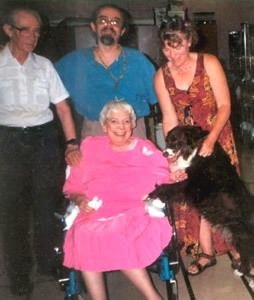
The Allens, a MacNaughton, and Jazz, 2000
No, really. Go through old photos, either low tech (photo albums) or on the electronic device of your choice. Take a look at photos of the people you plan on spending time with.
Also have a look at “oldies,” featuring those who are no longer with you… whether dead or moved on to greener pastures.
Let your eyes flow over faces, and pay attention to the stories that pop up. Likely, many of the stories will be “inflated…” stories designed to create warm, fuzzy feelings.
Others will be “conflated…” stories designed to confirm your worst thoughts about the person featured.
The thing to get is how easily the stories pop up, and how, if you decide to, you can focus on one and really flesh it out. But notice how inflated or conflated it is… how, the more you focus in, the more guesses and judgements pop up.
It’s just what minds do.
Now, have a breath. Let go of the stories and judgements, and have another look. This time, pretend you’re looking at strangers… looking at someone else’s family. Don’t try to do anything… just look.
This is how we begin to notice our story-making, and how “judgey” we are. How we notice our unreal expectations. For example, family dinners with Darbella’s family is decidedly different from my memories of Allen family dinners. And of course since different people were involved…
But judging one gathering “good” and one “bad” would be silly, as it’s based not on reality, but on inflated or conflated memories that only exist in my head.
This season, notice what projecting judgements on people and gatherings get you: hint–nothing good. Have a breath and be present with the people you are with.
2. Try a little tenderness

Grinch Much?
Some years ago I met briefly with the mother of a friend of ours. She really didn’t like her husband, and especially didn’t like him around the holidays. She had all kinds of stories about how he “ruined Christmas.”
My favourite: he was, as we were talking (it was October…) at home, putting up the Christmas lights. Which, she swore, “He always puts up wrong, just to spite me and ruin Christmas!”
I said, “Why don’t you go home and help him by telling him what you want him to do?”
Silence, with a glare. Then: “I’ll be damned if I’ll tell him. We’ve been married for decades, and he should just know what I want!”
Well, no. Not unless you want to keep your story going.
And many of us do, you know. Have mucho invested in how hard-done-by we are. Evidence to the contrary is ignored or demeaned. Because… poor me!
Tenderness isn’t just for meat anymore. Give the drama and “poor me” a rest. Ask for what you want, without judgement or rancour. If person “a” won’t or can’t do what you ask for… wait for it… ask someone else! Because… drama-free zone this Season.
3. Develop Your own Holiday Traditions

Some new traditions…
If your family gatherings are warm and fun, by all means enjoy them, and engage fully.
At the same time, see about setting up one tradition for your principal family (with your partner/spouse, and your kids, if any.) And if you don’t much like the Home for the Holidays trip, shorten it, eliminate it, book a trip, in short, change it.
In my family of origin, by the time I was a teen I was expected to help out with family dinners. In Dar’s family, not so much. My 30-something niece and nephew and significant others mostly just sit there. And don’t get me going on my brother-in-law…
But see? There it is. Everyone gathered, repeating the past, and me, wanting to grouse about it.
Another option, which will happen eventually anyway, is for the next generation to start planning their own events. You know, their own dinner parties, featuring them…
Stop looking backward and trying to recapture or repeat something. Instead, create ceremonies, activities and timetables that are meaningful for you.
Your task is to create a memorable life, for you. This requires actually doing something different.
4. Take it Easy, Baby

How about seeing the holidays as a time for reflection and renewal? A decade ago, there was a Zen Centre in Buffalo that Dar and I attended as often as we could. They had a Buddha’s Birthday meditation session December 8. We went, and sat for some hours.
Best gift I ever gave myself. Quiet time, reflective time. A chance to wind down, as opposed to the endless tearing about that the holidays seem to engender.
Not sure how the whole holiday thing turned into an endurance contest, but hey… you can call a halt by calling a halt. Take a break, take a holiday, take some time for yourself. If it doesn’t all get done, who cares?
5. Deepen, Deepen
This season is either a thing to be endured, with a fake happy face, or a time of reflection, self-knowing, intimacy and sharing — a deepening. You pick. You choose.
All moments are bare of meaning. We add meaning. Or, we go brain dead and numb and run (literally and figuratively) ourselves ragged as we attempt to avoid the pain we create.
Instead, capture this season and make it your own. Provide meaning to everything you do, real meaning, meaning significant to you. Use this time to deepen your commitment to your spiritual path, and to find more groundedness. This opportunity exists in each moment, and it’s up to you to use it.
In the end, your path is yours, and you make of it what you will. Strive for more depth, more understanding. Bring yourself back to bare presence. Invigorate and enliven yourself.
Celebrate the gift of living and being!

The post Going Home for the Holidays appeared first on The Pathless Path.
December 3, 2017
Meditation for Stress Relief
 Meditation to Find Your Core
Meditation to Find Your CoreOver the last several weeks, we’ve looked at stress and stressors. We’ve also had a look at using progressive muscle relaxation and setting boundaries as ways to deal with stress.
I’ll end this series by talking about meditation and Breathwork
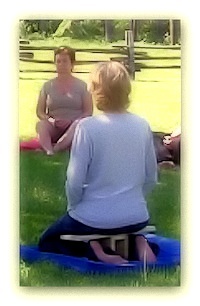
My own experience with meditation began in 1969, and good ole’ Elmhurst College. There was a Transcendental Meditation Group on campus, and I checked it out.
One thing I learned was that I didn’t like mantras — you got “given” one by the leader, and were supposed to focus on it as you “sat.” My little mind never did like being told what to do… at least by outsiders.
But I liked the idea of “just sitting,” and did so in fits and starts for some years. Some decades later, having spent much time reading Zen literature, I decided we needed some formal Zen training.
Off Dar and I went to the Toronto Zen Centre
The process there was pretty rigid and formal, and again, nether of us were fans. But the leader was kind of neat. We had a long “sit” and practiced a couple of the “normal” Zen techniques:
counting breaths
counting only in-breaths
This was preceded by lessons in how to sit.
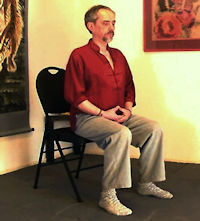
I still believe that “proper” meditation involves cushions and one of the approved of postures. But as I’ve gotten older, and because we are now tavelling most of the time (hence no cushions), I’ve come to believe that any “sitting quietly” time is better than none.
Let me outline a seated in a chair posture, and then give you a couple of focus suggestions.
I’m presently writing this in Spain and am sitting at the dining room table. The chairs are wooden. They’d be perfect for meditation.
You want a firm, solid, un-padded chair.
Sit on the front half of the chair, so your back IS NOT touching the chair’s back. Plant your feet firmly on the ground, maybe a foot or so apart.
Sit up straight. Imagine that a hook is attached to the top of your head, and is pulling upward.
Sway a bit side to side, feeling for “centre.” Sway a bit front to back, feeling for “centre.”
Keep your eyes open and relaxed, and tip your head down just a tad, so you’re looking 4–6 feet ahead.
Cross your hands in your lap.
Of course, there’s a video.
Click here for video
How to Quiet Your Mind
Meditation is not, as people often mistakenly assume, about emptying your mind of all thoughts. The nature of our mind is to have thoughts. Thoughts arise and will persist in doing so if we try to stop them. Buddhists call this the “monkey mind.”
Rather, we can give the mind something to do; whether that’s counting breaths, or simply watching itself do its thing.
Counting breaths: Our little minds do like assignments. This one is simple. Count each in-breath and each out-breath. Try to get to 20.
You won’t… but try.
You won’t because our minds get bored, and are also quite used to tossing up dumb thoughts. So, when a thought arises, have a breath, and start back at 1.
Just sit: There is a whole school in Zen devoted to “just sitting.” Instead of counting, just breathe comfortably. As a thought arises, say internally, “thinking.” Let the thought go.
Remember: Our tendency is to follow our thoughts. We see a scene from our past, and poof, we’re 20 and meditating at good ole’ Elmhurst College.
So, the goal here, such as it is, is to gently stop the thought-stream. As soon as you notice you’ve pulled an Elvis (you’ve left the building…) have a breath, and come back to just sitting.
Do either of these methods for 15 minutes per day. for a week or so. If it’s working for you, go for 30 minutes.
That is basically it. Thoughts will come and go. We do not need to lay any heavy trip upon ourselves for having thoughts. Just notice them, and remind the mind of its task.
Breathwork
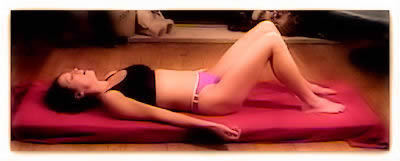
Breathwork is a Haven creation, and a great way to get into your body before or after a “day to remember.” No props necessary.
Lie on your back.
raise your knees so your feet are about one foot from your butt.
Move your feet so they and your knees are about a fist’s width apart. (Obviously, insert your fist between your knees to check.)
Close your eyes
Open your mouth an inch or so.
Breathe. The in-breath should fill your lungs and elevate your chest AND your belly.
Breathe out. On the out-breath, make a sound, starting with “ah.”
As you breathe, you can massage your jaw hinges.
Here’s a video!
Check out our page on Breathwork, here.
Give this a try, and notice how quickly emotions arise. Just let them come.
Next week, some ideas for surviving the Holidays!
The post Meditation for Stress Relief appeared first on The Pathless Path.
November 22, 2017
Setting Boundaries
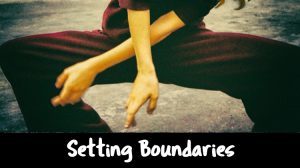
This is post 5 of 5 in the series “Dealing with Stress”
Setting Boundaries — one source for stress is a lack of boundaries, AKA the inability to say no.

Psst! Hey!
** Want more great writing designed to help YOU to shift your behaviour?
** Want to learn how to find, build or deepen your principal relationship?
** Want to know more about Zen living and being?
Last week I added a video to the article, forgetting that the article would be sent by email, which strips out videos. Here’s the link to the article and video on Progressive Muscle Relaxation
What Are Boundaries?
Personal boundaries are emotional, physical, and mental limits that we establish. Boundaries differ from person to person, and are:
based on one’s needs and desires
designed to protect him or herself from being used, manipulated, or even violated by others.
Setting boundaries is a personal responsibility, rooted in self-care and a desire to cultivate well-being. The premise is that no one and nothing can hurt you if you don’t allow it.
Please note that last clause: “…if you don’t allow it.” The only exception to this rule is physical assualt, which you may or may not be able to “stop,” depending upon your physical abilities. All other forms of “broken boundaries” happen because they are “allowed” to happen.
Boundaries are commonplace.
Countries have borders, homes have fences and doors, and offices are either separate rooms or cubicles which serve to maintain security and a sense of privacy.
Personal boundaries can serve us in the same ways.
Boundaries are crucial to healthy relationships, a healthy self, and a healthy life. Setting and sustaining boundaries is a skill that many people have not learned or mastered, but is essential for general well-being.
Boundaries are wide and varied:
Saying no to a friend who requests a favor that will infringe on your own well-being
Clear limits as to what you will or will not do in order to protect your health and sanity
Setting rules and ensuring your kids follow them while living at home
Setting limits within a romantic relationship as to what behaviours you will accept
Boundaries can also involve a personal decision as to how much you will tolerate in any given situation, for example needing to take a time out during an argument
Setting limits to protect your emotional health
Not doing things you don’t want to do or like to do just because someone else wants to
Setting time for work, and making sure that work does not interfere with family and leisure time
And, of course, setting limits in order to reduce stress, overwhelm and burnout
In essence, personal boundaries provide you with security and safety; they are your armour in ensuring self-care
It Is Not Selfish To Take Care Of Yourself

This is something we must realize when we want to learn to set boundaries and understand our limits. For many this is an obstacle.
Why are your needs any less important than those of others?
The belief that self-care is selfish is a false one. No one else can take care of you but you. No one else but you can understand and identify what impacts your well-being, sanity and stress levels but you.
When we put the needs of others before our own… we compromise our well-being, and this places an undue burden on ourselves and our relationships.
When we learn to say no, (or to set limits on what we will tolerate so as to not compromise our own personal values, needs and desires) we develop self-care, and this is the linchpin for reducing stress and living the lives we were meant to live.
The skill of setting boundaries is one of the most effective stress management tools. There are several reasons for this:
First, without boundaries you are likely to be running around doing everything for others, without taking care of your own needs. This is profoundly and fundamentally stressful. The lack of understanding your own needs, desires and limits makes it difficult to take care of yourself, and without self-care, stress is bound be rampant in your life.
Second, without boundaries it may seem that others are taking advantage of you, which can cause immense mental and emotional stress.
Third, the lack of a comfort zone (which is provided by setting limits) can make it seem that you are always living on the edge, without a safety net. This leads to stress and its consequent responses in the body.
Key Considerations In Setting Boundaries
Set and understand your limits — in order to have healthy boundaries, you must know where you stand. This means that you must identity your limits: emotional, physical, mental, and spiritual. Boundaries mean limits, and this means that you must be aware of what you can tolerate without stress or discomfort.
Self-care is at the core of boundaries — boundaries are individual and personal choices that stem from and support the need to take good care of ourselves.
What makes you uncomfortable may not be uncomfortable for others. This can become an obstacle, as others may exert pressure to “persuade you” to change a boundary.
Self-awareness — setting boundaries requires a deep level of self-awareness and honoring of our own feelings. For example, a friend calls and says she needs you to babysit, but you are exhausted and have had a long week, and were planning to just relax. At this point it is crucial for you to identify your fatigue — and your own needs — and not say “yes” — even though this will put your friend in a bind.
Deal With Personal Challenges — self-doubt, guilt, and fear are all potential pitfalls when it comes to our health, well-being, and how we set limits.
We may be fearful of how the other person will respond, or imagine they may not like us if we say “no” to them.
Guilt often prevents us from saying “no” and setting limits because we feel it is our duty to be helpful, to take care of others; to be good parents, friends, and lovers.
Doubting if we are deserving of the self-care that boundaries provide is another challenge that results in our doing more than we want to or are able to. This self-doubt results in us putting the needs of others before our own.
All of the above are issues that place focus on the other person rather than ourselves. They must be addressed before we can move forward to setting healthy boundaries. The truth is that letting self-doubt, guilt and fear make the needs of others more important than our own is a recipe for disaster.
Discomfort and Resentment —
Discomfort stems from doing or acting in a way that is beyond our comfort level. While learning to stretch out boundaries (another article!) is important, one has to have boundaries to begin with! Pressing against a boundary always results in discomfort.
Resentment occurs when you do not think you are appreciated or you think that someone is taking advantage of you. This occurs when we push ourselves beyond our own limits, (typically when we want to be good friends, wives, husbands, workers, daughters, sons, siblings and parents and we don’t want to say “no”.) Ironically, the resentment is misdirected, as it is you who has allowed yourself to go beyond your own limits, since no one can make you doing anything that you don’t want to do.
Being Direct — one of the key skills in setting boundaries is the ability to be direct with the people in your life. This means learning to say “no”. Saying “no” means using different communication styles with different people, but no matter who you are dealing with — be it parents, kids, friends or your spouse — setting boundaries requires a clear-cut and direct dialogue.
The Caretaker Syndrome — how you were raised can be a significant obstacle in setting boundaries. If you were taught to be a caretaker, and your family placed undue expectations on you when growing up, then ignoring your own needs is likely to be your norm. Consider all your relationships; is there a healthy give and take?
Some Ideas to Help You Start Setting Boundaries
Make Self-Care A Priority — Making self-care a priority requires that we give ourselves permission to put ourselves first, which motivates us to set clear and healthy boundaries at work, at home and in social situations. Self-care also means recognizing that your feelings are valid — and these feelings serve as essential cues about your happiness and contentment.
Be Assertive — it isn’t enough to create boundaries, we need to follow through. Even though we know intellectually that others aren’t mind readers, we still expect them to know what we want, what we hurt our feelings over, and what infringes on our limits. But, of course, they don’t know and they are not mind readers! It is critical that we assertively communicate with others about our boundaries, and let others know when they have crossed them — all in a respectful way.
Letting Go — of course, there will be people who will not understand or respect your boundaries, and they will continue to try to infringe upon them. Being proactive in your self-care likely will mean letting these people go, in order to remove toxic relationships from your life.
Get Help — you may need professional help to learn how to be comfortable with setting boundaries and with self-care in general. A good therapist can help you to get in touch with your issues, so you can be more present for yourself.
How To Establish Personal Boundaries
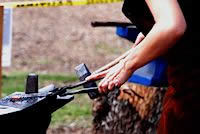
Boundaries are crucial to living a healthy life. Specifically, when thinking about reducing stress and risk for burnout, boundaries can save you the serious consequences that these situations can bring.
For anyone accustomed to being compliant and accommodating, the process of implementing boundaries may feel unnatural at first, or downright awful. However, as you stand up for yourself and your boundaries, you will feel increased confidence and empowerment.
Steps To Setting Personal Boundaries
Define
Write down how you have allowed other people to manipulate you, and how you have gone along with situations that are not acceptable to you.
Make a “boundary list” made up of things that others may no longer do to you, do around you, or say to you. List your values, your outlook on life, and your belief system.
Change Your Mindset
Start with the mind shift that having personal boundaries is good for you — that it does not mean that you are selfish or don’t care about others. Recognize that your self-worth is key to managing your well-being and avoiding stress, burnout and overwhelm. Realize that you are not defined by the acceptance of others.
Learn To Say No
Learning to say “no” is key to having healthy boundaries. We are able to better manage stress and avoid being burned out and overwhelmed.
If you have been a caretaker or a “yes man/woman” your whole life, it will be a foreign thing to say “no”, but you have to start somewhere. As you say “no” more often, be mindful of and note the rewards of self-care — this will motivate you to continue.
Expect Discomfort
You can expect that the “boundaries conversation” you have with others will feel difficult and uncomfortable, especially if you have been a people-pleaser. There may be some push-back and defensiveness from some people who have formerly “pushed your buttons.”
Be aware that some people in your life may fall away as a result of your new outlook, but these are not the kind of people you want in your life anyway.
Whatever you do, don’t compromise your values, self-respect, and dignity just to keep someone in your life. You just can’t sustain that.
Reinforce
It may take some time to train yourself to enforce and reinforce your boundaries. Create a plan for those times when someone actually crosses your boundaries. Tell them what they are doing. Ask them to stop right away.
Be Flexible
There is a big difference between rigid and healthy boundaries. Boundaries are fluid and can change over time and in different circumstances.
To use our previous example, with a twist: if a friend calls and asks you to babysit so they can go out to a club when you have made other plans or just want to relax, that’s one thing. It’s quite another if they have a medical emergency and really need to leave their kids. At this point, it would not be unreasonable for you to say “yes”. As you gain confidence, you will know how and when to bend your boundaries.
Be Patient With Yourself
Realize that this skill will not be perfected overnight, especially if setting boundaries is something that is new to you.
Start to become aware of, challenge and recognize the hidden beliefs that undermine your setting of boundaries. Make sure to always be clear about your boundaries, even when you are uncomfortable.
Believe In Yourself
You need to believe in your value as a unique individual who is worthy of self-care, calm and peace. Trust your feelings and instincts about what you don’t and do want in your life.
No one knows you or your needs better than you do. Never allow others to set your boundaries for you. You need to practice self-respect until it feels natural — setting boundaries is a good way to practice this.
Final Thoughts
Phew! Long one!
Setting boundaries is a critical skill for reducing stress, and preventing burnout. Boundaries are at the core of taking better care of yourself and this skill will go a long way to allowing you live a healthier, happier, safer, and more calm life.
Get started today!
The post Setting Boundaries appeared first on The Pathless Path.
November 15, 2017
Progressive Muscle Relaxation
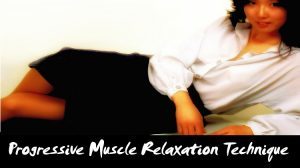
This is post 4 of 4 in the series “Dealing with Stress”
Progressive Muscle Relaxation — an oldie but a goodie! The next few articles are about getting into your body

Psst! Hey!
** Want more great writing designed to help YOU to shift your behaviour?
** Want to learn how to find, build or deepen your principal relationship?
** Want to know more about Zen living and being?
We switch gears now, and have a look at several techniques for dealing with stress — all without drugs.
Back when I was counselling for a living, I was pretty well known for my aversion to drugs… and by that I mean “mind drugs.” I still get a bit incensed over the push to medicate, despite most of the drugs being of questionable effectiveness.
And then there’s the whole process of weaning people off of the drugs they become addicted to. But we’ll let this topic go for another day.
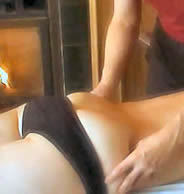
Because of my interest in Bodywork, of course my focus would be on the physical things we can do to deal with the effects of stress.
Wilhelm Reich, the father of Bodywork psychotherapy, was the first to grasp what people did with stressors. He noticed what he called “character armour.” In other words, when stressed, people tighten their muscles, and soon, the acute tightening becomes “chronic.”
Bodywork provides a way out — using pressure on the “tightened part” creates the environment to “let the stressor go.” Not only do you discover how and where you “hold” stress, you also discover that even deeply held stress can be “dropped.”
Sadly, finding Bodyworkers is difficult.
The good news is that you can get a handle on what your body is doing. In a second, I’ll walk you through an exercise you can try. But I also want to make a couple of Bodywork suggestions.
Alternatives to Bodyworkers:
Deep tissue massage therapists (Rolfers, deep tissue): The Rolfers I’ve worked with really get in there. Best if you decide to to a “full round” or Rolfing, which involves multiple sessions.
Acupressure: some acupressure people know about Bodywork — you’d have to ask around.
“Regular” massage therapists: again, ask around. My experience has been mixed to negative, as even massage therapists who advertise as “deep tissue” really aren’t pushing all that hard.
Lastly, “regular” massage therapists are NOT trained to deal with the emotions that arise from deep Bodywork. Most will immediately pull back. I’ve never come up with a solution for this.
Progressive Muscle Relaxation Technique
A video featuring the muscle relaxation technique
This muscle relaxation technique doesn’t require much exertion for it to be effective; that’s probably why it is so popular. It works best on the type of muscular tension that causes body aches and headaches — pains that you have likely had for days; pains that may even have “gone background” — you might not even realize they are still there.
Progressive muscle relaxation uses subtle movements to relieve tension and to begin to relax. The method is based on the idea that it’s easier to relax muscles by making small movements.
By tightening each muscle group and then releasing it, you start to feel more relaxed and less stressed.
It’s all about exaggerating each conscious “tightening and release” -– you become more aware of your muscles — more aware of when you’re holding tension. You then use the muscle relaxation technique to reduce your stress levels before the stress has a chance to get out of control.
How To Do Progressive Muscle Relaxation
The first step is finding a room to practice this – it should be relatively quiet, dimly lit, and you should be able to sit comfortably or lie down.
Close your eyes and start breathing deeply through your nose. Hold your breath for just a few seconds and then release it through your lips. Do this several times, and imagine that your body is becoming heavy and warm. Release any tension that you become aware of.
Continue to breathe slowly and clench both of your fists, then tighten your biceps and hold the tension for several seconds. Now release the tension and let it ebb away. Your focus should be on the changing sensations in your muscles. As you allow the tension to flow from your arms, hands, and fingers keep your hands open to shake off the remnants.
Now, continue this pattern through each of the major muscle groups in your body.
Facial. Start by raising your brows and furrowing your forehead. Then squeeze your eyes closed as tightly as possible, and then clench your teeth. Finally, squeeze your face like a toddler would do after eating lemon for the first time. HOLD for five seconds, then slowly release.
Neck. Slowly pull your chin toward your chest. Then turn your head to the right, then to the left, then back to centre. You should keep your shoulders relaxed but straight while you practice this technique. Tighten your neck muscles. HOLD for five seconds, then slowly release.
Chest. Puff your chest out and take a deep breath. Tighten your entire chest. HOLD for five seconds, then slowly release.
Shoulders. Shrug your shoulders, pushing them back for a few seconds, relax and then pull them forward. Roll your shoulders upward. HOLD for five seconds, then slowly release.
Upper Back. You can either sit in a chair and allow your back to rest against the chair, or place a rolled up towel or bolster under your upper back. Push your body so that your upper back arches. HOLD for five seconds, then slowly release. (If this is uncomfortable or causes you pain then you should skip this one.)
Abdomen. Pull your stomach in and then push it out, tensing it as though you were expecting a blow. HOLD for five seconds, then slowly release.
Legs. Lift your leg and tense your calf and thigh muscles (prepare for cramping) and bring your toes toward you. Do each leg in turn first and then raise both of them before finally pointing your toes out as far as possible. HOLD each move for five seconds, then slowly release.
Feet. Point your toes (all while keeping your legs down) and then pull them toward you before finally digging your feet into the floor. You should breathe deeply while you practice this exercise. HOLD for five seconds, then slowly release.
As you work through each group of muscles, you will feel warmth enveloping your body as you finally relax.
After you complete the exercise, take some down time and allow your muscles to rest. Just enjoy the relaxation before you rush back into action. You’re transitioning from total relaxation so you don’t want to undo your hard work by jumping up and diving back into your day.
While the total amount of time required to complete this exercise will vary from person to person it really doesn’t take much time at all. Remember to give yourself enough time to pause for 30 seconds between muscle groups, and to enjoy the peace once you have finished.
You may choose to do this in total silence, but relaxing music is an effective way to block out any background noise, which may break your focus.
The post Progressive Muscle Relaxation appeared first on The Pathless Path.
November 8, 2017
The Effects of Chronic Stress

This is post 3 of 3 in the series “Dealing with Stress”
The Effects of Chronic Stress — stress is debilitating, and often goes un-noticed until damage is done
We’re in our lovely Andalusian casa for the next 9 weeks! Looking forward to not living out of a suitcase!!!

Psst! Hey!
** Want more great writing designed to help YOU to shift your behaviour?
** Want to learn how to find, build or deepen your principal relationship?
** Want to know more about Zen living and being?
Let’s review:
Stress is normal, and stress comes in flavours.
There’s distress (what we might call bad, or chronic stress)
there’s neutral stress (day-to-day stuff that requires a response)
and what Hans Selye (the father of stress research) called eustress (from the Greek eu — good, as in euphoric (good) feelings) or good stress.
Today, we’ll be looking at the effects of distress, or chronic stress.
As we’ve noted, all stress begins the same way. We are confronted with a “confusing or threatening” situation, and our bodies react well before our minds get involved.
We’re wired that way.
This wiring is ancient, and comes from a time when life was short, harsh, and brutal. Our forebears were the ones who survived long enough to breed. And they survived by having sensitive stress triggers.

Something flashed in the periphery, and “fight or flight” clicked in. The third option, “freeze,” usually led to a dead relative.
The most important thing to get is that the “fof” (fight or flight) reaction is chemical. Your brain, for the most part, just checks out and comes along for the ride.
Because thinking slows you down.
“Hmm, I think I saw a blur. I think it was orange and black, and something was glittering… could that have been teeth? Gee, I wonder? Was that blur a tiger stalking me? Maybe I should run away, or pull my sword… I wonder…”
Snap. Crunch. Lunch.
OK, so you get it. The chemical process that causes “fof” is instantaneous, for a good reason. The problem is, most of us in the 21st century are not dealing with tigers, so the need for big reactions is limited.
Our threats are more subtle.
But the body still reacts — An Anatomy Of Stress Inside Your Body
We all know how our bodies feel when under stress. Regardless, it is good to visualize what is going on inside the body.
The Heart And Blood Vessels
The heart is a muscle in the purest sense of word; a healthy heart has very little fat, and is extremely efficient, contracting like clockwork for the duration of your existence.
However, stress hormones change all this. Under their influence, the heart starts to beat much more rapidly, partly in response to the stimulating action of these hormones, but also because blood vessels are constricted.
To understand this, think of a water pump.
You can use a one-half inch pipe to supply water, or a one-inch one. When using the half-inch size, the pump needs to work harder to push the same volume of water. It is similar with your heart, except that it has a quota to maintain to make sure your cells don’t die from oxygen starvation.
The Digestive System
You ever notice that when under stress or anxiety, you feel “butterflies” in your stomach, and find it difficult to hold your food — or bowels? This is directly the result of stress hormones.
Under stress, the stomach produces more acid, which either helps speed digestion (and the desire to empty your bowels) or creates acid reflux and heartburn. This is why stomach ulcers are more frequent in people who are under high stress.
In the intestines (since food seems to move faster than usual,) nutritional deficiencies can occur, along with diarrhea.

The Respiratory System
Respiration is tied intimately to our circulatory system. During exercise, your heart pumps faster and you breathe faster. This is because your body needs (is expending) more oxygen. For most people this is not a problem, but for asthmatics or those with pulmonary disease, stress can precipitate asthma attacks, or constriction of the airways, making it difficult to breathe.
Hyperventilation is also common, and a characteristic of a panic attack.

The Reproductive System
Nothing wrecks one’s sex life like stress, as millions can testify. This isn’t just psychological, however, but also physical. In men, the stress hormone cortisol interferes with the normal production of testosterone, so the sex drive crashes. In women, menstrual cycle disturbances occur, which can cause painful periods or wildly fluctuating hormone levels throughout the month.
The Endocrine Glands
Endocrine glands are those body parts (including the adrenal glands, the liver and pancreas) that produce hormones, which are then deposited into the body’s blood stream.
Under stress, the adrenal glands produce more cortisol and adrenaline — the two key stress hormones. In response to this, the liver may begin releasing stored glycogen in the form of glucose, as a response to your seemingly agitated state. The pancreas may also begin producing more insulin, and if the stress response resolves, everything goes back to normal.
If the stress response does not resolve, the hormones continue to circulate, and the feeling of low-grade agitation continues.
A stuck Body Leads to a Stuck Brain
 On fire… and not in a good way
On fire… and not in a good waySo, all of that quivering, tight, tensed up stuff is the first bodily reaction to a stressor. To say it again, this reaction is normal, so long as it “goes away” along with the stressor.
Modern life, however, seems to have created a “stress state.” By this I mean a perpetual state of agitation. From a biological point of view, the stress hormones never turn off completely.
Just a drip, drip, drip.
Our bodies are designed to seek balance — homeostasis — BUT can be tricked by circumstances to have a “moving checkpoint.” It’s like how our eyes adjust to bright lights… ouch, then… normal.
I used to see this a lot during Bodywork — a client would assure me that their body “wasn’t that tight.” I’d look and think, “Wow! Tight!” So, I’d push, and suddenly it was, “Ouch, ouch, ouch!”
 One spot is fiery red — a sign of a physical blockageMOXA
One spot is fiery red — a sign of a physical blockageMOXAOr I’d use moxa (A Japanese herbal substance you light like incense and apply to the body) and boom, there would be red spots, indicating “blockages.”
The key here is to get that stress is not required. The settings your body and mind are “at” are arbitrary. There are ways to reset things… and from there, to notice what “real normal” feels like.
We’ll be looking at these ways, in turn, over the next couple of articles.
The post The Effects of Chronic Stress appeared first on The Pathless Path.



